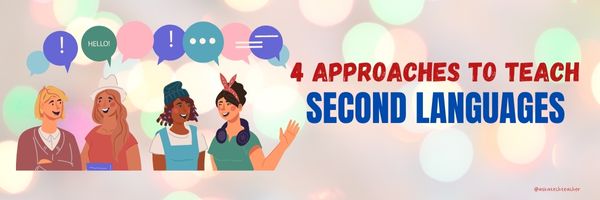Learning a second language for many is complicated. Some of us are naturals at linguistics, others, not so much. Teaching means adapting to different students who learn in different ways. Here are four proven approaches, from the Ask a Tech Teacher crew:
4 Approaches to Effective Second-Language Teaching
In an article from the Michigan State University website, children who are skilled in at least two languages are known to possess cognitive flexibility. This allows them to focus on one task and effectively switch to another task. It’s not surprising for parents to want their kids to learn a new language. Training them is another story, one that second language teachers will need to handle.
Generally, there is no one effective approach to teaching a second language, which could be challenging given the individual differences and backgrounds of learners in a classroom. All it takes is knowing the strategies that help them attain full mastery of a target language. Check out the list below and see what approaches will aid you in teaching a second language:
- Get to know your learners
First interactions are critical to the rest of the learning process. Here, you allow learners to talk about themselves in their native language. Ask them about the things they do for fun when they’re alone and with friends. You can also get them to talk about their favorite TV shows, cartoons, and comic books.
Icebreakers are always great if you want to make this part of their first day fun and socially engaging. Try tech tools and games like two truths and a lie so that everyone becomes familiar with each other. Beyond the classroom, you will need to understand where your learners are coming from. Talk to their parents and find out about the kind of household environment each learner lives in. Doing so will help you get a better the
- Use visual stimulation
The hardest part about teaching a second language is the limited vocabulary that learners have. If they don’t understand a single word you say, consider using visual aids such as photographs and illustrations. It also helps if you could show videos demonstrating the use of grammatical concepts and vocabulary in the real world. Look for ones that show a dialogue first in the native language and then in the target language.
During lectures, you will need to use gestures and facial expressions to help learners infer the meaning of a word. These are fun to do, especially if you get your learners to show what “happy” and “sad” looks like. For more advanced concepts such as prepositions or non-count nouns, the use of props is highly encouraged.
- Provide positive error correction
When a learner makes a mistake in terms of word choice and sentence construction, punishment won’t work in helping them to recognize an error and avoid repeating it. Error correction should instead focus on guiding the learner to discover what they got wrong without telling them “You’re wrong.”
You can do this positively by telling them they did a good job except for the part of the error. If they said “I went on the room,” tell your learner that they got one word off and that they should replace it with a more appropriate one.
Give a review of the concept if you have to. Use illustrations to help them find out. If “on” is used to show an object’s position on top of another, then draw a person on top of a drawing of a room. The learner will then notice this mistake and will repeat the same phrase using the correct word.
- Make the experience immersive
There are plenty more ways you can help your learners develop a mastery of a second language and many of these aren’t practiced in the classroom. Social and cultural immersion activities are still the most effective way to help learners see how the target language is used in everyday life. Schools and institutions like World Kids School apply this concept to help students learn Spanish and Mandarin more interactively and you should, too.
Set aside time to take your learners on a field trip to a community or cultural event where they are exposed to the target language more authentically. If it’s not possible to immerse them outside, you can let them watch movies and films that use the target language. Make sure the content is age-appropriate and offers learners a unique view of how cultural and social norms affect language usage.
Endnote
Teaching a second language isn’t so simple if you are dealing with learners with limited knowledge of the target language. As a teacher, your approaches should cater to the individual differences of your learners and appeal to the kind of learning experience they’re more comfortable with. It takes time and effort, but coming up with the right approach will help your kids master their communication skills and develop their appreciation for cultures apart from their own.
Here’s the sign-up link if the image above doesn’t work:
Jacqui Murray has been teaching K-18 technology for 30 years. She is the editor/author of over a hundred tech ed resources including a K-12 technology curriculum, K-8 keyboard curriculum, K-8 Digital Citizenship curriculum. She is an adjunct professor in tech ed, Master Teacher, webmaster for four blogs, an Amazon Vine Voice, CSTA presentation reviewer, freelance journalist on tech ed topics, contributor to NEA Today, and author of the tech thrillers, To Hunt a Sub and Twenty-four Days. You can find her resources at Structured Learning.







































2 thoughts on “4 Approaches to Effective Second-Language Teaching”
Comments are closed.